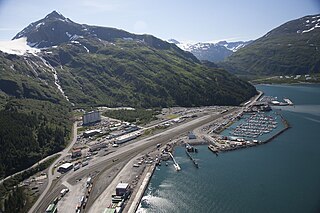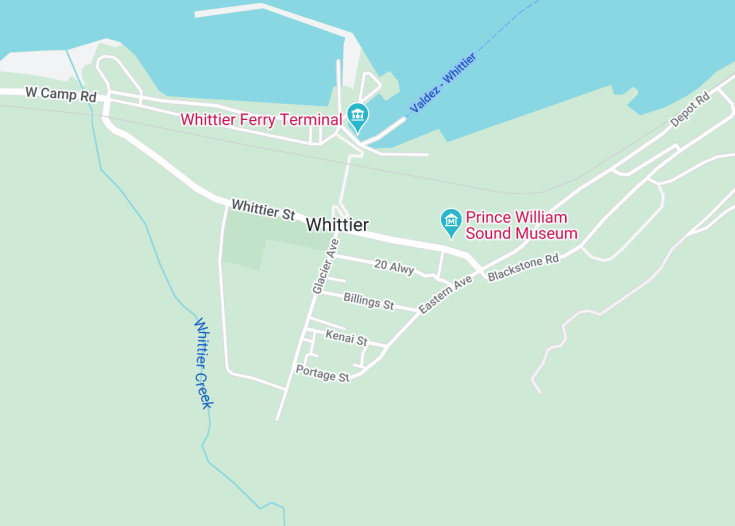Whittier, Alaska, a hidden gem nestled amidst the Chugach Mountains and accessible primarily through the Anton Anderson Memorial Tunnel, the longest highway tunnel in North America, offers a unique blend of stunning scenery and history. This secluded town, originally built as a military facility during World War II, is now a peaceful yet vibrant community. Visitors can explore remnants of its past, enjoy marine activities in Prince William Sound, or hike in nearby trails offering breathtaking views. Despite its small size, Whittier’s strategic location makes it a gateway to spectacular glaciers and wildlife adventures.
For an unforgettable experience, schedule a boat tour in Prince William Sound to witness majestic glaciers and diverse marine wildlife up close.
Consider staying overnight in Whittier to fully immerse yourself in the serene, picturesque environment and experience the true essence of this quaint Alaskan town.
Top things to do & see in Whittier
Select the following sights and activities to discover best tickets and tours available in Whittier.
Whittier: Gateway to Prince William Sound
| Country | Alaska (USA) |
| Time in Whittier | GMT-9 |
| Language spoken | English |
| Population | 282 (U.S. Census Bureau, 2020) |
| Currency | U.S. Dollar (USD $) |
| Airports | The nearest major airport: Ted Stevens Anchorage International Airport (60 mi / 97 km). |
Whittier, located within the Chugach National Forest in Alaska, serves as a crucial hub for marine access to the mesmerizing Prince William Sound. This unique town is home to approximately 282 residents and is notably accessible primarily through the Anton Anderson Memorial Tunnel, the longest highway tunnel in North America. The town’s strategic location and direct access to pristine waters make it an important site for both commercial and sport fishing, as well as tourism.
The origin of Whittier began during World War II when the U.S. Army constructed a military facility and harbor. Post-war, the city transitioned into a commercial port and eventually evolved into a popular destination for tourists. Its rich history is overshadowed by awe-inspiring natural landscapes, including glaciers, mountains, and ocean views that attract thousands of visitors seeking outdoor activities such as kayaking, fishing, and sightseeing cruises. The local community, though small, is vibrant and tightly-knit, often navigating the challenges of secluded life with a spirit of resilience and interdependence.
Where is Whittier?
Whittier is located on the northwestern edge of Prince William Sound in Alaska, approximately 60 miles southeast of Anchorage.
Distances:
| Route | Distance by car | Time by car |
|---|---|---|
| Anchorage to Whittier | 60 miles | Approximately 1 hour and 20 minutes |
| Fairbanks to Whittier | 358 miles | Approximately 6 hours and 30 minutes |
| Juneau to Whittier | requires air travel | not applicable |
What is Whittier famous for?
Whittier is famous for its direct access to Prince William Sound’s spectacular coastal wilderness, which has made it a prime spot for water sports, wildlife viewing, and glacier tours.
History
Before 1940s: Pre-establishment Era
Located in the picturesque passage of Prince William Sound, Whittier, Alaska has a concealed history beginning long before its establishment. The area was primarily inhabited by the Chugach Eskimos, who utilized the region for fishing and hunting, benefiting from its rich resources and strategic location. The tranquil beauty of the region remained largely undisturbed until the 20th century when geopolitical interests reshaped its destiny.
1940s-1950s: Military Development
Whittier’s transformation began during World War II when the U.S. Army identified the area as a strategic location to safeguard Alaska from potential invasions. Construction of military facilities including a harbor, barracks, and most notably, the Anton Anderson Memorial Tunnel—the longest combined rail and highway tunnel in North America—marked this era. This period established Whittier as a crucial military outpost, shifting its narrative significantly from a secluded fishing area to a fortified military zone. After World War II, the military presence remained, though it began to decrease in intensity as threats diminished.
1960s-Present: Communal & Touristic Development
Post-military, Whittier gradually developed into a civilian township, officially incorporating in 1969. Transitioning from a strictly military installation to a public community presented challenges, particularly its remote accessibility, primarily depending on the Anton Anderson Memorial Tunnel which initially only catered to railway traffic. Over the years, adjustments were made allowing both vehicle and train passage. Today, Whittier has embraced its heritage and picturesque landscapes, evolving into a unique, albeit small, tourist destination. Interest in its historical military buildings, alongside the natural beauty surrounding the town, and unique aspects such as almost all residents living in a single building—the Begich Towers—continue to attract curious visitors.
Visit Whittier
What to see and do in Whittier, Alaska
Whittier, Alaska offers a blend of historical intrigue and natural beauty. Visitors are drawn to the fascinating history of the Begich Towers, where nearly the entire population of the town resides. The Anton Anderson Memorial Tunnel, an engineering marvel, also attracts many. For nature enthusiasts, the surrounding Chugach National Forest and Prince William Sound provide breathtaking views and activities like kayaking, fishing, and glacier cruises.
- Begich Towers
- Anton Anderson Memorial Tunnel
- Prince William Sound cruises
- Fishing and kayaking in Chugach National Forest
Annual Events in Whittier
Whittier hosts several annual events that reflect its rich culture and community spirit. Notably, the Whittier Ice Fest, held in March, showcases ice sculptures, native art, and winter sports. During the summer, the Whittier Fish Festival in July celebrates the local fishing industry with competitions, fresh seafood, and family activities. These events offer a glimpse into the local lifestyle and provide visitors with unique, memorable experiences.
Best time to visit Whittier
The ideal time to visit Whittier is between May and September when the weather is most favorable for exploring the outdoors. This period provides the best conditions for wildlife viewing, fishing, and partaking in local cultural festivals.
Is Whittier worth visiting?
Whittier is certainly worth visiting for those who appreciate a mix of history, uniqueness, and natural splendor. It provides a distinctive experience due to its compact community living and its significant past roles, both military and indigenous. The access to unspoiled landscapes, coupled with a chance to see northern wildlife and participate in various outdoor activities, makes Whittier a unique gem in Alaska.










